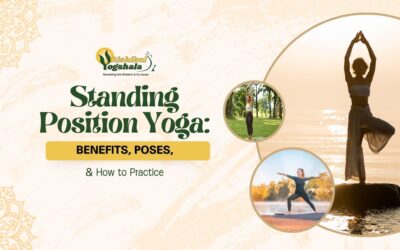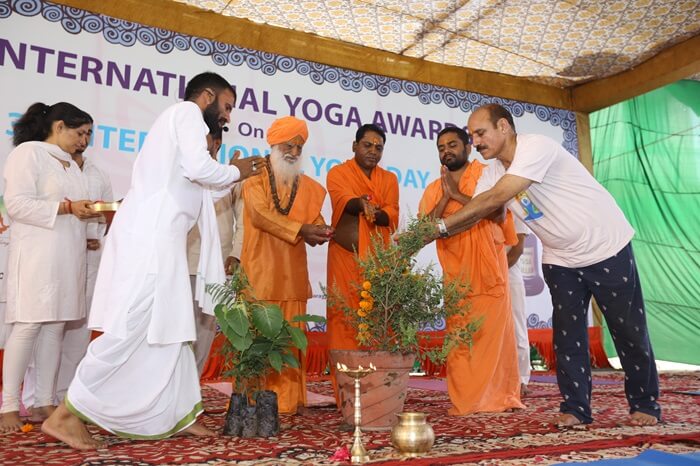Today, we’ll discuss Sirsasana, also popularly known as the headstand. They say it is the “king of asanas” because of its multiple health benefits and the level of mastery needed to perform this very asana. So, if you want to add this pose to your yoga routine, you have to learn the proper technique behind it, understand the benefits, caution yourself against precautions, and avoid injuries.
We will take you through how to perform Sirsasana safely, the amazing benefits of the headstand, and a range of different modifications that you can try as you build your strength and confidence.

Sirsasana Steps: Step-by-Step Process
Follow these simple steps to attempt Sirsasana clearly:
- In the back-knee pose: Kneel down on the mat, then bring your bottom back onto your heels; relax for a few breaths to settle in.
- Join your hands together: Come onto your knees from your Child’s Pose, join your fingers together, and place your forearms onto the ground. Your elbows must be shoulder-width apart.
- Head position: Sit back on a mat with the crown of your head resting lightly in your hands and the back of your head resting on your hands.
- Lift your hips: Press the heels of your hands on the ground, then drive through the legs to lift up and under the hips toward the sky and come into a dolphin.
- Walk your feet forward: Continue walking your feet forward over your shoulders until your hips are over your shoulders.
- One-leg hang on side up: Slowly lift one leg off the ground and up into the air as you engage your core, and then slowly lift the other leg off the ground and upwards to meet it.
- Holding and breathing in headstand: From full headstand, press into a hold for 10-15 breaths, keeping your centre of gravity, keeping your body balanced and aligned.
Slowly put your legs down one at a time, and come back down into Child’s Pose for some breaths.
Also Read : Top 7 Health Benefits of Halasana (Plow Pose)
8 Sirsasana Modifications to Try
If you are not prepared for the complete Sirsasana or would like more of a challenge in doing advanced variations, try these seven modifications. These modifications will build strength, balance, and flexibility, adding variety to your headstand practice.
1. One-Leg Sirsasana
This modification allows you to practice balancing on one raised leg while the other remains on the ground. This practice is excellent for strengthening and stabilizing muscles in the core and arms:
- Do the same steps again; but this time, lift one leg at a time into Sirsasana.
- Tuck in the other leg and touch the floor. Then you can use that as an ‘anchor’, which might give you better-balancing control.
- Switch legs after some breaths in Sirsasana.
2. Wide-Legged Sirsasana
Extend your legs all the way wide out so that they would make a ‘V’ shape from where you already are balancing in the full headstand position. This is a challenging variation of Sirsasana wherein most of your inner thigh muscles will be engaged and asks for even better control on balance.
3. Headstand with Eagle Legs
Cross your legs as you do in a variation of Eagle Pose-a balance challenge that works your hips and core:
- From a balanced Sirsasana, cross one leg over the other, enfolding your calf around the opposite leg.
- Hold for a few breaths, then repeat on the other side.
4. Twisted Headstand
With good balance in the fundamental Sirsasana, turn the torso slowly to one side for a twist. This adds an additional level of challenge and involves the obliques.
5. Niralamba Sirsasana (Unsupported Headstand)
This variation is a more advanced take on the traditional headstand and requires significant core strength and balance. In Niralamba Sirsasana, the arms are not used to support the head, making it a true test of body control. Follow these steps to attempt this advanced posture:
- Begin in the foundational Sirsasana position, but rather than interlocking your fingers, stretch your arms straight out in front of you or to either side of your body.
- Slowly raise your legs, keeping all your weight on your head and neck.
- Use your core as much as possible to maintain resistance to turning forward or backward.
Because this asana is so challenging, it should only be attempted by advanced students.
6. Salamba Sirsasana I (Classic Supported Headstand)
This is the classic Sirsasana. In this asana, the forearms are used to provide support for the head and make a firm base for the head. Headstand for beginners can improve balance, strengthen the core, and enhance overall body alignment with consistent practice. It is one of the first asana variations novices are taught. Here is how it is done:
- From a kneeling position on the mat, interlace your fingers. Place your forearms shoulder-width apart on the floor.
- Place the crown of your head on the mat, and allow the back of your head to lightly rest upon your interlaced fingers.
- Walk your feet over towards your head, lifting your hips up off of the ground to sit in this position with your spine reaching straight up.
- Lift one leg and then the other up into the air, wrapping your abs in for support.
7. Salamba Sirsasana II (Tripod Headstand with Elbows off the Ground)
This is done with arms out to the sides and elbows raised. It challenges the core and shoulder strength even more. Do the following:
- Place palms down on the ground with the distance between your hands like your shoulders are apart.
- Roll forward, crown of the head on the mat in-between, creating a tripod position. Your elbows stay off the ground, lifting up your body with core and shoulder strength.
- Lift your legs slowly in the air and balance on your hands and head.
8. Salamba Sirsasana III – Preparatory Pose for Forearm Stand
It’s a transitional version of the forearm stand. It’s hard to do it without incredibly powerful muscles in your arms as well as shoulders. Here is how to do it:
- You start in the position of Salamba Sirsasana I with forearms put on the floor and fingers interwoven.
- Start to transfer your weight from your head down onto your forearms and push up so that you lift your head off the ground.
- Focusing on stabilization with the arms and torso as the head is lifted
Each of these variations in Sirsasana pose offers unique difficulties and benefits and can only be cultivated over time by the practitioner as they deepen in their practice.
The Incredible Sirsasana Benefits

Practising Sirsasana, commonly referred to as headstand, is one of the easiest poses that eventually bring about massive results on physical as well as mental levels. Some of the major sirsasana yoga benefits have been mentioned as follows:
- Better circulatory system: In an inverted position, gravity will work in the favor of taking blood closer toward the brain and, at the same time, it would bring clarity towards your thoughts even when you are calmed.
- It strengthens the core and shoulders: In practicing headstand yoga, the body is extended vertically, and lots of stability is required thus doing it builds core strength and endurance in the upper body.
- Activates pituitary and pineal glands: These glands are very crucial in hormone regulation, and doing sirsasana may well help balance the hormones in your body.
- Alleviates stress and anxiety: Inversion calms down the mind and reduces stress; it’s even believed to provide an extremely deep sense of relaxation.
- Improves digestion: Practicing headstand yoga regularly will stimulate your digestive system, treating constipation and other disorders concerning your intestines.
While doing headstand yoga, you’re not only exercising your muscles but also refreshing your whole body. Learn how to do Sirsasana (Headstand) with this step-by-step guide! Master balance, build strength, and boost mental clarity safely by joining our 200 hour yoga teacher training india or 300 hour yoga teacher training in india.
Also Read : 7 Excellent Health Benefits of Karnapidasana (Knee to Ear Pose)
Here’s What You Need to Know Before Performing the Practice
While Sirsasana is a position that has many wonderful benefits, it is actually done best by the mind. Here are a list of do’s, don’ts, and most common mistakes to be avoided:
Do’s
- Warm up properly: Use stretches such as Dolphin Pose or Downward-Facing Dog to get your entire body moving while activating your core and shoulders.
- Engage your core: Your abdominal muscles help hold a huge part of your body in place while doing Sirsasana, so make sure they are engaged throughout.
- Use a wall for support (if needed): You may use a wall to support you; this especially comes in handy when you are new and not yet very confident.
Don’ts
- Don’t lock your elbows: You should keep your elbows at a comfortable angle. In case you lock them, there is the possibility of injury from hitting them.
- Do not jump into position: Enter the position slowly and under the control of one leg at a time rather than jumping in with the risk of falling.
- Do not hold your breath: Keep breathing smoothly while balancing in the posture to avoid dizziness or undue strain.
Common Mistakes
- Overloading the neck: Many people tend to put too much weight on the head and neck. Ensure that most of your body weight is borne by your arms and shoulders.
- Poor Alignment: Body from the hips down to your heels must be perfectly straight for a headstand. A misaligned headstand can place extra pressure on your back.
In this manner, you will have ensured that you fully derive the benefits of Sirsasana without wrecking yourself.
Read More – Sirsasana (Headstand) – Top 10 health benefits
Conclusion
This is one of the most transformative yogasana poses because it offers a countable number of positive effects on both physical and mental-emotional levels. Be it an age-old practitioner or a newcomer who has recently started a headstand; one must always focus on alignment, control over breathing, and step-by-step progress. Mindful giving into such modifications will empower him not only to master Sirsasana but also to improve his yogic practice at other levels.
















